Read Part 1
After exploring the working principles and general design features of iron-air batteries in Part 1, in this ongoing series we delve into the unique advantages and innovations that make iron-air batteries a standout choice for sustainable energy storage.
Positive air electrode
For a typical bifunctional Co-Ni oxide air electrode in KOH electrolyte, the predicted equilibrium potential for oxygen is about 0.3V versus Hg/HgO. The actual electrode potentials at which the reduction and the evolution of oxygen occur (at current density ±20 mA cm–2) are -0.22 and 0.66V vs Hg/HgO, respectively. The overpotential values are 0.52V for reduction and 0.36V for evolution. These large deviations from the reversible value pose a problem in finding a catalyst that can decrease the overpotential.
To compensate for the sluggish rate of oxygen reduction, two air-breathing electrodes are used per iron electrode. To increase efficiency, a fan may be used to supply air, and a pump can be employed in the electrolyte circuit to remove heat through a heat exchanger and for electrolyte purification.
It has been identified that MnO2 and Ni-Fe layered double hydroxides are good inexpensive bifunctional catalysts. Additionally, perovskites like La0.5Sr0.4Co0.2Fe0.8O3 (LSCF), LaSr3Fe3O10 (LSFO), and La0.6Ca0.4CoO3 (LCCO) supported on glassy carbon are alternative air electrode materials that can be used instead of costly conventional noble metal Pt/Pd/Ru-based catalysts.
The reduction of oxygen on perovskites proceeds through a 4e- process, which is more efficient than the 2e- reduction mechanism. The structure of a perovskite also enhances the rate of oxygen evolution. Bifunctional oxygen catalysts have limited electrical conductivity, so a supporting material like carbon blacks is necessary with which the catalyst is bonded, as they combine high surface area with reasonably high conductivity.
As shown in Fig. 10, the air electrode has a more complex design than the iron electrode, as it requires a hydrophilic layer containing the catalyst on the side facing the electrolyte. It also requires a porous hydrophobic layer, termed the ‘gas diffusion layer (GDL),’ on the reverse side to allow oxygen to diffuse into the electrode.
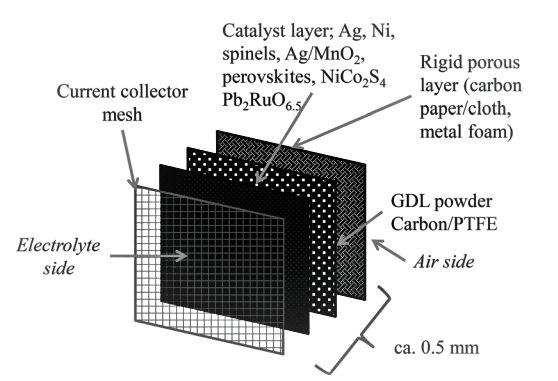
It is necessary that GDL pores are not flooded with the alkaline electrolyte; hence it is made of microporous conductive carbon powder treated with PTFE (polytetrafluoroethylene) or a similar alkali-resistant hydrophobic polymer. Oxygen from the air diffuses through these open pores towards the hydrophilic catalyst layer flooded with electrolyte. The GDL layer is mounted on a scaffolding made of a rigid porous layer of carbon cloth, metal foam, or porous PTFE to improve structural stability, porosity, hydrophobicity, and conductivity. The catalyst layer is composed of catalyst powder pressed together with conductive carbon powder, which is cheap but has poor corrosion resistance at strongly oxidising positive potentials. Alternatively, an air electrode can be made where both GDL and the catalyst are nickel-based in the form of spinel-catalysed nickel powder and nickel foam to achieve good stability and current density as high as 100mA cm–2 at a recharging potential of +0.55V versus Hg/HgO.
The overall thickness of the air electrode has a large influence on cell performance. A gas diffusion electrode should have a thickness of 0.1mm maximum, typically 100–400µm, to reduce the time needed for oxygen to diffuse through the GDL. A very thin catalyst layer allows the OH- in the electrolyte to diffuse more rapidly towards the catalyst during oxygen reduction and allows the oxygen bubbles to escape from the catalyst during oxygen evolution. The corrosion of carbon-based GDLs may cause the degradation of the electrodes, reducing cycle life. Hence, metal-based materials like Ni foam and stainless steel/titanium mesh are preferred as media for gas diffusion.
Composite air electrode preparation
The composite air electrode consists of an electrocatalyst layer, a current collector of Ni mesh, and a PTFE layer, which are sandwiched together. The catalyst layer is prepared by mixing all ingredients like perovskites, graphite, and spinel in a solvent in the required proportion and then blending in a blender rotating at 6000rpm. The blended solution is filtered, and the paste of the catalyst is rolled onto a 100 mesh Ni screen. The pasted electrode is pressed at 375kg/cm2. The other side of the electrode is then painted with PTFE solution. The assembly is then sintered at 325°C in an N2 atmosphere. The PTFE layer acts as a waterproof gas-diffusing layer (GDL), providing larger gas transport pores, which contribute to a fast and uniform supply of oxygen while preventing the leakage of electrolyte. The electrocatalyst layer can also be formed by electrodeposition of catalyst material on carbon cloth. Thereafter, the gas diffusion side is provided with a rigid porous layer of carbon cloth or metal foam by cold press.
Bifunctional catalyst
Charging and discharging reactions in Fe-air batteries involve oxygen evolution reactions (OER) and oxygen reduction reactions (ORR). The ORR at the air electrode involves several steps:
- Oxygen from the atmosphere is brought to the catalyst surface, where it is absorbed on the active site.
- Electrons from the catalyst are then transferred to oxygen, resulting in weakening and removal of the oxygen bond.
- Finally, the catalyst surface releases hydroxide ions to the electrolyte.
OER is the exact opposite of ORR. However, these two reactions are slow, and a large overpotential is required to overcome this sluggishness. This means there is a voltage loss that reduces the capacity utilisation of the cell.
To offset this problem, active bifunctional electrocatalysts like noble metals, perovskites, spinels, and non-noble metal catalysts are required. Noble metal catalysts like Pt, Pd, and Pt alloys for ORR, and RuO2 for OER are the best, but their prohibitive cost limits their commercial use. Non-noble metal catalysts like transition metal oxides of perovskites, spinels, pyrochlores, and layered double hydroxides are preferred due to their low cost, ease of manufacture, robustness, stability, durability in alkaline electrolytes, and high bifunctional OER and ORR activity.
Spinels are AB2O4 structure compounds, where A is rare earth divalent ions like La, Ce, Sm, Nd, etc, and B is a transition metal trivalent ion like Cr, Mn, Fe, Co, Ni, etc. One such spinel, Co3O4, with its tetrahedral sites partially substituted by Ni, Mn, Cu, or Zn, and MnO2-perovskites mixed catalysts performs well for bifunctional applications in alkaline medium.
Layered double hydroxides (LDH), another important class of catalysts, are mixed valence, ionically conducting solids with a layered structure of Ni-Fe, Ni-Co, Co-Fe, Ni-Mn, Co-Ni, etc., where the interlayers are filled with carbonate, nitrate, and chloride ions. They can be easily oxidised to highly active hydroxides for the OE reaction.
In both spinel and LDH, the surface active compounds are metal hydroxides and oxyhydroxides, which have high conductivity and activity and are stable.
Nanostructured carbon-supported transition metal atoms or metal alloy nanoparticles show good ORR and OER electrocatalysis. Heteroatoms such as N, B, and P can be incorporated into carbon frameworks for enhanced electrocatalytic activity through electron modulation. Moreover, these dopants also serve as anchoring centres to attach metal atoms or metal alloy particles through strong coupling effects, forming electrocatalytically active and stable M-N-C molecules, as shown in Fig. 11.

Cobalt (Co) nanoparticles and N-doped carbon provide electrocatalytic ORR activity, and the network constructed by carbon fibres and nanotubes ensures high electrical conductivity and a porous structure. The development of bifunctional ORR/OER electrocatalysts can be very useful for metal-air batteries’ discharge and charge processes. Hybrid material of cobalt-coordinated porphyrin (superb hydrophilic surface with accessibility to electrolyte) covalent organic framework-coated CNTs can be used as a bifunctional catalyst.
Metal oxides like Mn, Co, Ni, and Fe oxides, can also be used as bifunctional catalysts because of their intrinsic activities, low cost, and structural stability. Integration of metal oxides with nanostructured carbon supports provides an excellent conductive network and accessible surface area to facilitate electron transfer and mass diffusion during ORR and OER.
It has been found that there is another class of efficient and stable bifunctional non-precious metal composite catalysts comprising metal-nitrogen-carbon (MNC) for ORR, and metal oxyhydroxide as OER catalysts. Transition metals containing nitrogen-doped carbon catalysts, especially of the Fe-NC type, have been reported to have excellent ORR activity in both acidic and alkaline electrolytes.
The addition of cobalt leads to a very good performing catalyst with an OER/ORR gap of 0.79V, high output, and high cycle life. The bifunctional behaviour is attributed to an interaction of CoN4 centres for the ORR and Co-oxide particles transforming to hydroxides for the OER.
Table 1 shows some of the properties of recently developed bifunctional air electrodes.
| Table 1 Properties of recently developed bifunctional air electrodes | |||||
| Catalyst Type | Supporting Material | EORR V | EOER V | jmax ORR at -0.2VmA cm2 (current density) | Lifetime Number of Cycles |
| (vs. Hg/HgO) | |||||
| Ag | Sintered Ni powder | — | — | -80 | 500 |
| Ag-MnO2 nanorods | Graphite powder | 0.0.03 | 0.61 | -0.25 | 270 |
| Perovskites | Ketjen black glassy carbon | -0.08 | 0.29 | -200 | 100 |
| Spinels LaMnO3 | Carbon black | -0.09 | 0.60 | -10 | 150 |
Negative iron electrodes
The iron (Fe) electrodes are generally made from powdered materials that contain metallic iron or iron oxides, most commonly Fe3O4, which is supported on conductive material like carbon in order to increase the conductivity and surface area. Instead of using commercial Fe3O4 powder for making Fe electrodes, the use of nanosized particles of iron is the best strategy to make more of the solid electrode accessible to the electrolyte, as this step increases the surface area, resulting in more charge capacities. Carbonyl iron electrodes have been found to increase the discharge-specific capacity even though their particle size is not nanosized. The discharge products like iron hydroxides of iron electrodes are insulating in nature and can passivate the electrodes, resulting in further oxidation.
Research has indicated that special carbons like graphene, multi-wall carbon nanotube, and amorphous carbon composites admixed with copper and tin have the potential to enhance iron electrode performance by suppressing hydrogen evolution. A variety of compounds like Bi2S3, Bi2O3, FeS, and Na2S are added as pore formers to the Fe electrode to reduce the rate of hydrogen evolution and increase the charging efficiency. In the electrode, pore formers create enough electrolyte access to the reaction site. The best result is obtained when 5% (by wt) Bi2S3 is used as an additive. Bismuth sulphide decomposes in a redox reaction by forming iron sulphide as shown below:
Bi2S3+6e–<——>2Bi+3S2–
S2–+Fe(OH)2<—->FeS+2OH–
Iron sulphide enables a high discharge rate via depassivating the oxide, modifying the electrode kinetics, and increasing the solubility of iron hydroxide, making the reaction fast. The metallic bismuth increases hydrogen overpotential and charging efficiency from 50% to 90%. The presence of sulphide derivatives decreases the detrimental effect of iron passivation on the electrode by forming a conductive layer of FeS by reacting with Fe atoms. When iron oxide nanoparticles supported on tubular nanotubes of carbon particles are used as Fe electrodes, it has been seen that they yield a higher specific capacity and charging efficiency. Table 2 shows the properties of various Fe electrodes.
| Table 2 Properties of Iron electrodes | |||||
| Iron Material | Particle Size µM | Support Material | Additives | Discharge Specific Capacity Ahg–1 | % Charging Efficiency |
| Commercial Fe3O4 particles | 1-3 | None | None | 0.12 at C/5 rate, 9mA cm–2 | 70 at C/5 rate |
| Carbonyl iron | 0.5-3 | None | 5% Bi2S3 | 0.29 at C/5, at 3mA cm–2 | 96 at C/20 |
| Fe3O4 | 0.02 | Carbon nanotubes | K2S | 0.79 at 0.5mA cm–2 | 84 |
Cu-doped, Cu-Sn-doped, and Sn-doped nano iron active materials have been used recently as negative electrodes in alkaline batteries and showed stable, improved performance. The presence of Cu increases electrode kinetics, increases surface roughness, and reduces ohmic resistance upon cycling. Cu-doped electrodes have a performance of 360mAh g–¹ at 80% charging efficiency. Cu-Sn-doped nano-iron/carbon composites with CNT and LiOH addition increase the performance to 603mAh g–¹ with 93% charge efficiency due to uniform distribution of Cu, Sn, and Fe in the carbon network. However, cycling stability reduces due to a higher rate of hydrogen evolution at different voltages. Below 1.5V, hydrogen evolution is minimal, and above 1.65V, it is maximal, causing rapid electrode failure. Charging at high current density increases the charging efficiency and performance while reducing hydrogen evolution due to current limitations for the hydrogen evolution reaction. Accordingly, the most optimum voltage and charge current density are selected to develop the charging algorithm. The iron anode section of a prototype iron-air battery, being fabricated at the works of Form Energy, USA, is shown in Fig. 12.
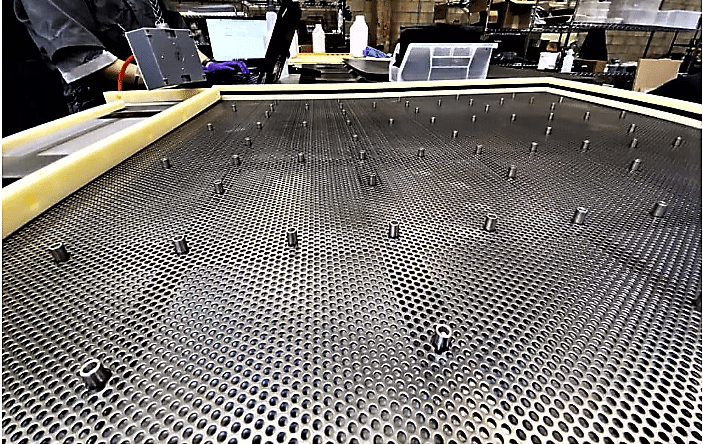
Electrolyte
For metal-air batteries, alkaline electrolytes are generally preferred over acidic electrolytes due to their higher ionic conductivity, safety in operation, and reduced corrosiveness to electrodes. A solution of potassium hydroxide, which has good electrical conductivity and is moderately corrosive to the iron electrode, is used as the alkaline electrolyte in iron-air batteries.
During electrode reactions, metallic iron is oxidised to form Fe(OH)2 and other oxidation products, which are sparingly soluble in the electrolyte. The low solubility helps to avoid the formation of dendrites, a harmful product. Often Na2S, K2S, and LiOH are used as electrolyte additives. The first two compounds work like bismuth sulphide, but over time become less effective due to non-uniformity of sulphide absorption on the electrode interface.
Recently, organosulfur compounds like n-alkanethiols were successfully used to suppress hydrogen evolution. Sulphur adsorption masks the electrocatalytic surface and remains stable over several cycles. An advantage of using organosulfur is that recycling the spent electrodes is much easier compared to those containing bismuth.
If LiOH is used, Li ions are absorbed in the iron hydroxide matrix, increasing the ionic conductivity and reaction kinetics of the iron material. The insinuated compound can be easily reduced back to iron. It has been found that the addition of potassium stannate as an electrolyte additive increases the capacity and efficiency to 400mAh g–¹, with 85% charge efficiency. The tin deposits on the iron electrode suppress iron evolution.
The use of ionic liquids like 1-ethyl-3-methylimidazolium L-(+)-lactate (EML) as an electrolyte additive plays a major role in suppressing hydrogen release and anode passivation. EML has many desirable properties, such as high ionic conductivity, low vapour pressure, high chemical and thermal stability, and it is non-flammable. Their structure can be varied by incorporating different cations and anions.
The efficacy of EML as a hydrogen evolution inhibitor is most optimal when 1.0mM EML is added to the alkaline electrolyte of 6.0 M KOH solution. At this optimal concentration, it has been found that the hydrogen evolution rate is drastically reduced and is 35 times less than if no EML is used. Charge transfer resistance at the electrode during the hydrogen evolution reaction remarkably increases (about 50 times) with the addition of EML, due to adsorption of EML molecules on the cathodic sites of the iron electrode forming passivation layers of iron lactate. This passivation layer leads to a decrease in the cathodic reaction, resulting in minimal hydrogen evolution.
The surface morphology of the iron electrode, when examined by SEM and EDX, establishes that the iron electrode in blank electrolyte, i.e., 6.0 M KOH, is composed of a compactly stacked passive layer only, whereas if 1.0 M EML is used, the same surface becomes smooth without the formation of any passive layer. The addition of EML enhances the iron-air battery capacity more than three times as can be seen from Fig. 13.
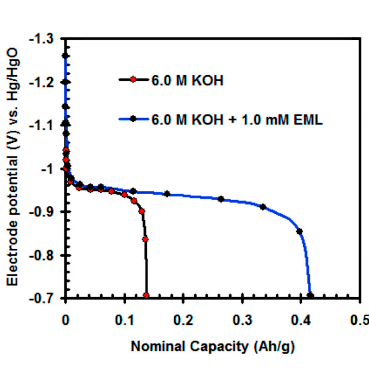
As can be seen from Fig. 14, average capacity retention is about 58% after 385 cycles if no EML is used. But with the addition of 1.0 M of EML, capacity retention increases to about 94% even after 1000 cycles.
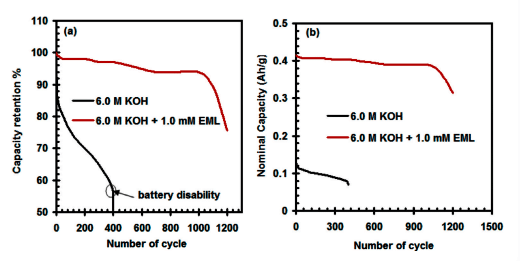
Lithium batteries are very good at cycling many thousands of times. However, if there is a battery that discharges for a week and then charges for a week, the theoretical maximum number of cycles one could get out of the battery is 26 per year. So, if the battery could provide 500 cycles, it would have a 20-year life. If the priority is a low-cost battery, there is no need to consider thousands of cycles like a Li-ion battery. The key is to make the right trade-offs in pursuit of the attributes that are important.
At present, grids are provided with storage batteries that allow them to smooth out multiple days of intermittency associated with renewable power generation driven by weather. However, these batteries are quite costly, and this is where the gap is filled by iron-air batteries, which cost one-tenth of lithium batteries and whose iron electrodes have about 4000 cycles and air electrodes about 1000 lifetime cycles.
Ups and downs
Advantages
Iron is the fourth most abundant element on Earth and inexpensive, which overcomes a significant problem with using lithium, a costly and rare element. The use of iron curtails the extensive use of water in lithium mining and groundwater contamination.
Iron-air batteries can provide energy grids with dependable, safe, efficient, and longer-time energy storage capabilities than conventional technologies. While Li-ion batteries can provide about four hours of energy storage capacity, iron-air batteries can provide up to one hundred hours of storage. Therefore, iron-air batteries can function as a bridging technology during energy gaps, such as cloudy days, which would otherwise limit solar power plants.
When it comes to volumetric energy density, iron-air batteries perform better than Li-ion ones. At 9700Wh/l, they are about five times as high as today’s Li-ion batteries (2000Wh/l). So, they are of particular interest for use in mobile appliances, where space requirements play an important role. Iron-air batteries are ten times as cheap as their Li-ion counterparts. They contain no toxic elements, and the electrolyte is not flammable. So, they are quite safe.
Disadvantages
Iron-air batteries are large and recharge slowly. Their energy density is low and likely to stay that way, so there is no chance that this will become the favoured battery technology in the transport sector.
Challenges
Measures need to be taken to reduce the battery weight and increase electrode capacity, which is achievable through using a multi-cell bipolar stack with lightweight and cost-effective graphite bipolar plates. Electrode capacity can be increased by producing active mass of iron via electroplating, which is cost-effective. Using potash or caustic soda lye as an alkaline electrolyte should result in better coupling to the current collector. Moreover, the electrochemical deposition process can be used for targeted passivation of the electrode surface to prevent side reactions without impairing the actual function of the battery. This action would prevent the parasitic generation of hydrogen.
Market projection
Metal-air batteries are considered the most preferred replacement for lithium-based and other types of batteries, which are now widely used. The ability of metal-air batteries to use abundantly available and cheap metals like zinc, aluminium, and especially iron lowers manufacturing costs. The specific density and energy capacity of these batteries are higher than those of lithium-ion batteries.
The use of abundantly available metals as anodes and air as oxidants attracts manufacturers to produce these batteries on a commercial scale. Because of the lucrative opportunity to gain huge profits, manufacturers are now working with various research laboratories to improve the performance of these batteries.
The global metal-air battery market size was valued at $445 million in 2021 and is projected to reach $745 million in 2028, with iron-air batteries potentially holding about a 20% share of the total global market by 2030. Fig. 15 shows the projected market share of various types of metal-air batteries in 2028.
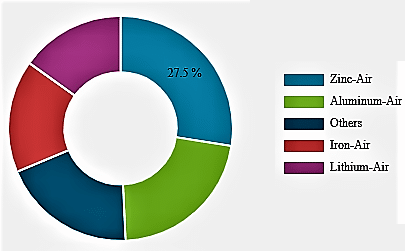
Cost analysis
Form Energy is a company that has built a $760 million factory on 55 acres of land in West Virginia, USA. They have improved this 140-year-old technology and are likely to start commercial production of iron-air batteries in their new facility in 2024. Current estimates indicate that iron-air batteries could cost around $25 per kWh capacity, compared to up to $200 per kWh for Li-ion batteries.
Basis of cost estimate for iron-air battery:
Plant capacity: Manufacturing 100,000 packs/year
Designed power: 110kWh/pack
Open circuit voltage: 1.36V
All items are outsourced, and the plant assembles the same to produce battery packs.
Cost break-up:
1. Cost of material and hardware: $12/kWh
This includes active material and current collectors for negative and positive electrodes, carbon, binders, electrolyte, separator, battery jacket, all hardware, etc.
2. Cost of air delivery system comprising air compressor, pressure swing adsorption system to concentrate O2, piping, instrumentation, electrics, etc: $7/kWh
3. Cost of pack integration: $3/kWh
4. Labour cost, sales promotion, administration, overhead, R&D, depreciation, warranty, profit, etc: $3/kWh
5. Total unit cost (addition of 1 to 4): $25/kWh
The cost breakdown in circular template is shown in Fig. 16.
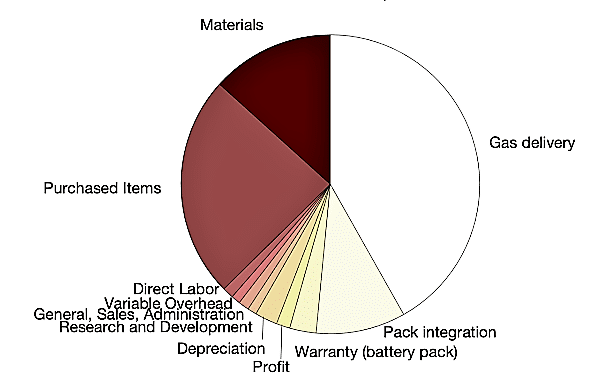
Iron-air batteries are not a replacement for Li-ion storage systems but rather a complement to them. Li-ion batteries have a high power-to-weight ratio or energy density while maintaining a small size, which is ideal for EVs. They are also great for fast response actions like frequency regulation and grid stabilisation.
In contrast, iron-air batteries would be best at storing and supplying large amounts of energy at lower power and density. They are designed to be hooked together in grids. The same chemical process that ruins a steel structure, if not painted, could help power the electric grid in the future and may save the planet from doomsday due to climate change. It is the process of reversible rusting: while rusting the iron electrode, the battery discharges, and while charging the iron-air battery, we are pushing electricity back in. The battery is unrusted.
There is enough cheap iron available on our planet and utilising it in the battery makes it possible to keep electric grids running 24 hours a day on intermittent, but inexhaustible solar and wind energy. The 140-year-old technology in a new avatar can provide backup energy to power electric grids not just for days, but months. However, getting there would require more research and development work. It is expected that within a few years, commercial production of this type of battery will start.
Rathindra Nath Biswas is a 1964-batch chemical engineering graduate from Jadavpur University, Kolkata. He was awarded a certificate for designing Benzol Plant by Giprokoks, USSR, and Certificate of Honour by Indian Institute of Metals. He has published 35 research papers in various journals. He retired from service as Head – MECON, Durgapur.






